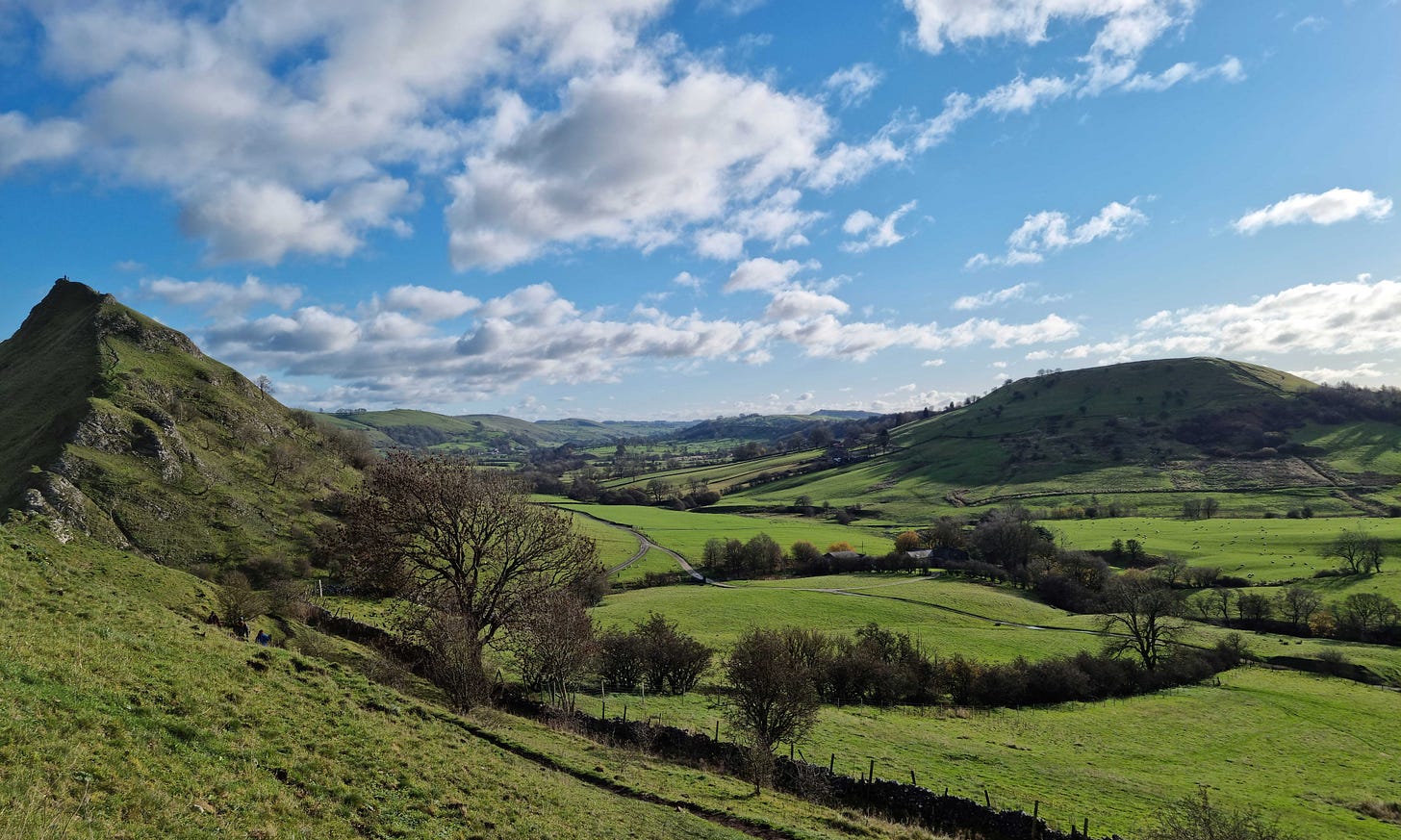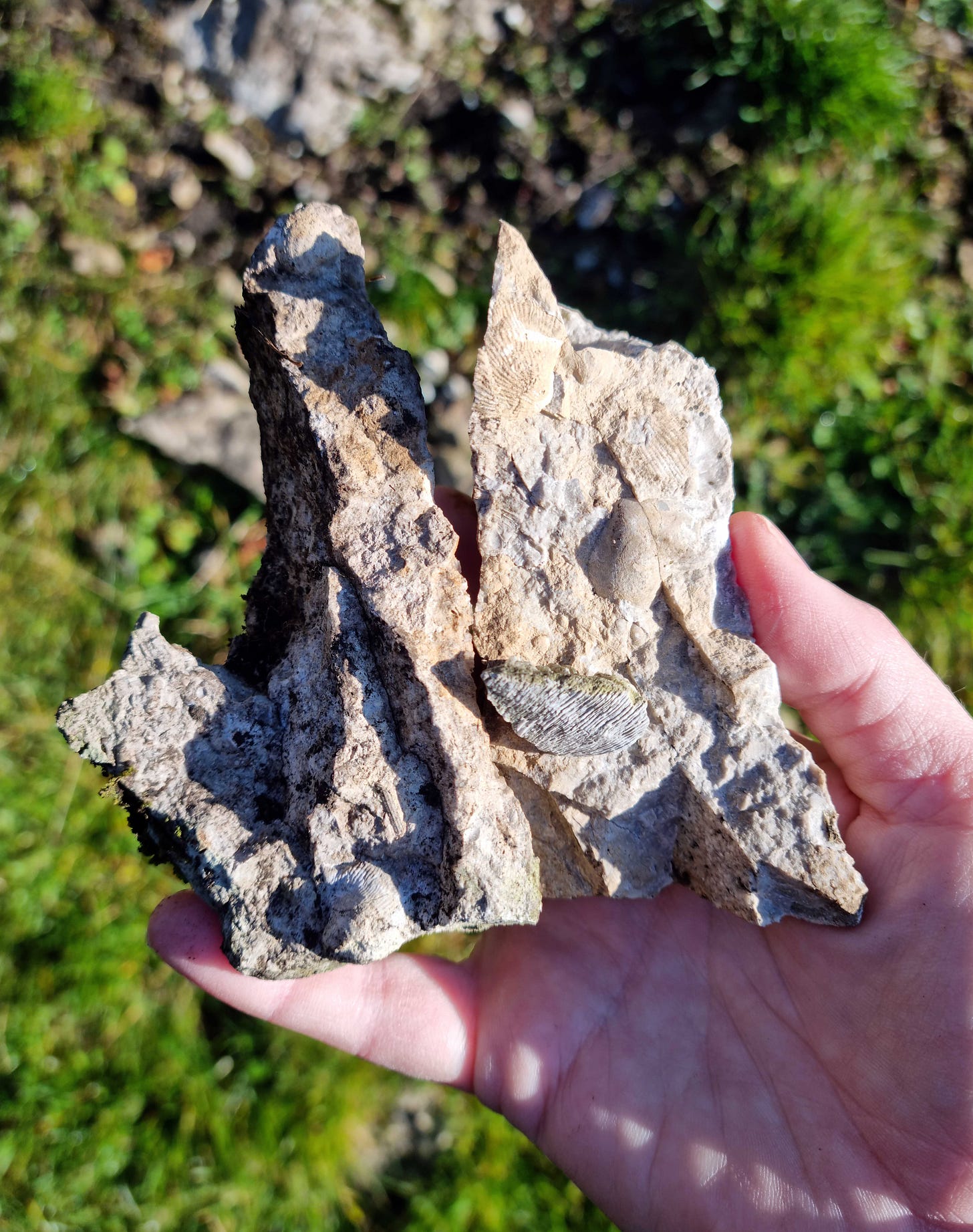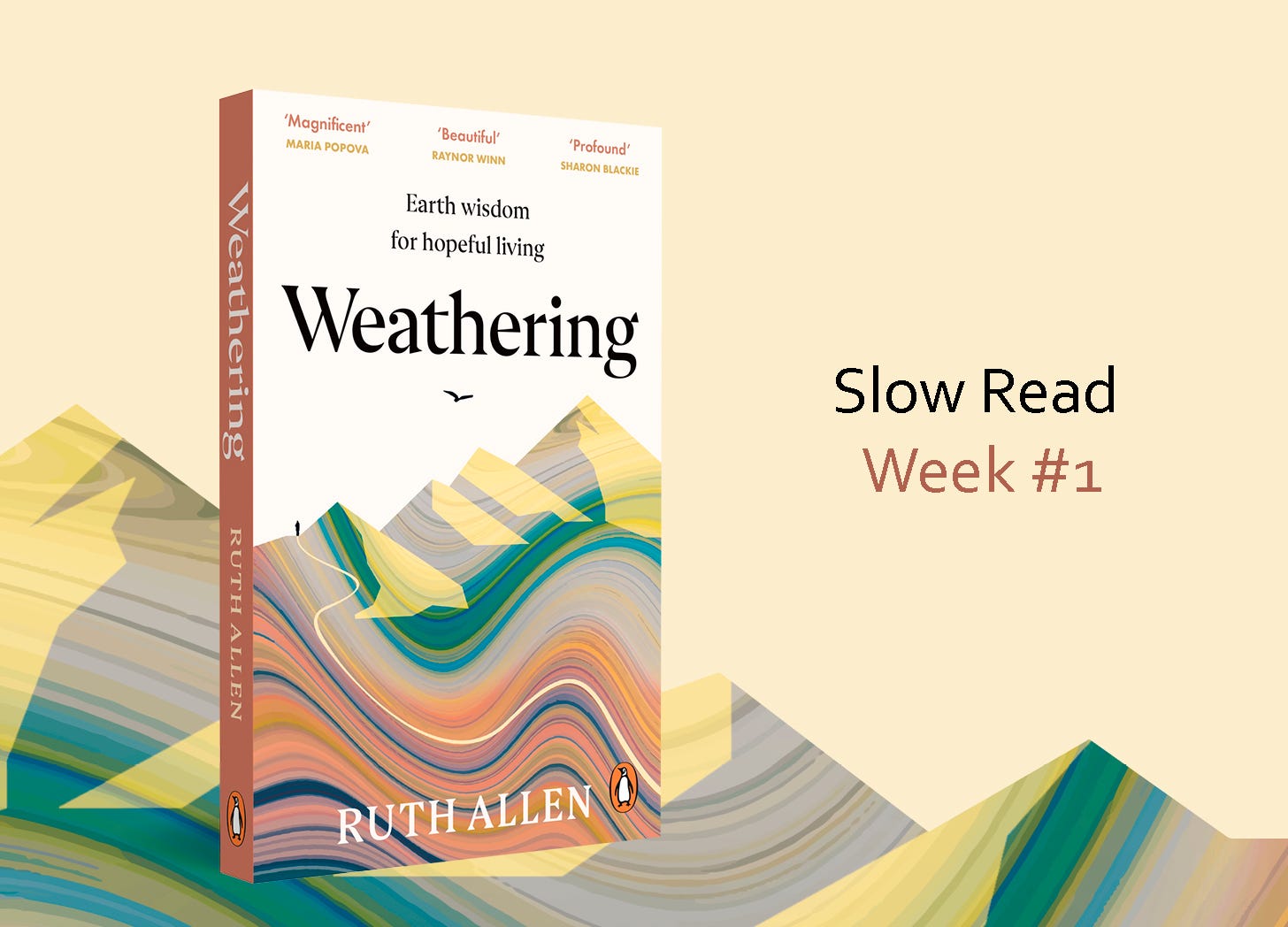Weathering Book Slow Read Week #1
C0 Introduction 'chapter' 0: A Primer on Relationships
Here we are! At the beginning of our slow read of Weathering together. If you haven’t read the post that introduces this 9-week series then you can find that here. It includes the schedule and what to expect. But without tonnes of pre-amble then, let’s start start our journey, shall we?
And Weathering is a journey: a journey through the some of the geological highlights of the Peak District National Park, Derbyshire, here in the UK. And a journey through life in some ways. No small task to write! Through this journey we might meet our limitations, our edges, our losses and grief, our fears and even our own aging. But as the newly minted subtitle on the paperback tells us this is also a journey through Earth Wisdom for Hopeful Living. The keen eyed among you will notice that this is a more hopeful inflection on the original hardback subtitle, and perhaps reflects differently the solace that I hope the book brings you whatever you’re experiencing, whenever you’re experiencing it. It is not only a book for storms, but a book for preparedness and consolation for whatever arises. It is a book of guideposts (and we meet more of those in week 6!)
Where the Introductory ‘chapter’ starts at one shoulder season, we begin at the other as winter is leaving rather than arriving. In the book, I am standing on Chrome Hill, and you are with me seeing my thoughts. In some ways I am both surveying the actual horizon as winter approaches, and also surveying the landscape of the book to come in ways literal and metaphorical. Together then this week of our slow read, we are taking a look around, which necessarily requires a look back before we move forward. I am telling you a bit about my background and how it came to be that I did my studies and PhD in Geology before far later down the line I retrained in psychotherapy. You might be someone who doesn’t like to look back – and I generally put myself in this category – but at the same time, it can be instructive. It can hold keys to new understanding. And it can show us things we might want to go back and retrieve. If there is one truism I am experiencing in midlife, it is that it’s a time of retrieval.
I’m giving the Introduction to the book its own week, because it is really a chapter about ‘coming back’ to myself, which itself is really about relationship. And that’s what this chapter and this whole book is about. Relationships, relationships, relationships. The one we have with ourselves, the ones we have with others, and the one we have with the natural world around us. Of course, on the surface this book is about what it means to weather our lives, but it’s not that simple either. It’s really all about that interpersonal stuff and how it shapes us, and also reveals us, and acts as a buffer to erosion. Throughout this slow read I am going to ask you to look around you, your life, and your environment in all directions from wherever you are on your own hill. You could even use this image in a mindful moment or (walking) meditation next time you have a moment by yourself.
Coming back to ourselves
Touring the hardback one question came up time and time again (sometimes I think everyone is more interested in this than anything else in the book) – how and/or why did I make the switch between geology and psychotherapy? Was it sudden? Was there an epiphany? Did I always intend to weave these threads of my life? How long has it taken? And I get it. It is interesting. Why do any of us follow the paths we follow? What is the balance of chance and intention? I love to hear these stories of unexpected professional collisions too, which is why I started the book from this vantage point. I’ve given some sort of explanation a go in the book, but it’s really hard to explain inherently mysterious things, succinctly. I would need a whole evening with you to explain the twists and turns, the unexpected surprises and the heartache of leaving worlds behind only to find myself (at first at least) an imposter in others. Perhaps some of you have trodden a similar path with trepidation and anguish?
But let me say this in addition, I believe in world-building. I believe in the worlds we build for ourselves, some of which will only ever live inside of us, and never see the light of anyone else’s day. I believe, profoundly, in following intuition, always in the direction of what interests and excites me and I am still doing that to this day. World building is a heartful and brave craft. It involves a lot of personal honesty, and a capacity to tolerate feeling like an outsider, maybe even to enjoy being a species of the gap, as I call it. It involves a lot of ‘no, thanks’ to stuff we are apparently supposed to want, and a lot of ‘yes, please’ to going the long way round with no obvious outcome in sight.
And this too: when you feel on your own like this, you have to make sure you’re a friend to yourself, which involves keeping your old selves in sight at all times. Pay attention, never throw anything away, or disregard something, that has come from within you. A bit like how as a writing mentor, I say never bin any of your old writing. You never know what might come back and can be reused. This isn’t quite the same as hoarding, think of it more as staying speculative. Over the years, I have had to learn to be judicious with myself, to hold all parts of myself old and new with equanimity, to listen to myself well, to hear what’s calling me back (as well as calling me forward) and to be compassionate in view of those parts of myself I might at least temporarily abandon for perfectly good reasons. Geology or, more accurately, geological processes – are an important part of my way of seeing the world even though I no longer work as a geologist (whatever that means!? Afterall, I am more of a geologist than I have ever been, it would seem…) and it took a strange sort of stubborn courage to stand alongside myself in this way and wait for it to make its return.
OK, so let’s do some reflecting:
1. What are you coming back to at this stage in your life? Are there things that you have left behind that you feel yourself yearning for again? What have you lost touch with? What might be calling for your attention and reconnection?
2. What special knowledge do you carry with you from your life or experience that guides you through? Are there particular metaphors that make sense to you, natural or otherwise?
On page 13, I talk about the open-endedness of personal development, which incidentally, is not to say that we have to be doing ‘The Work’ on ourselves endlessly to ward off our inherent insufficiency! Not at all. It’s just to say, that often in the present we don’t know where we are. We’re getting through as best we can. It is only from higher up the hill that we can really see what was unfolding and when.
3. What sense do you have of the time you are living in personally, relative to where you have come from? How does this fit (or not) with the times you feel like we’re living in collectively? Do you carry anything within you, that is helpful for the times you find yourself in?
It’s funny. Geology is a very old sort of science. Rock-bothering is older still when you consider the whole, you know, Stone Age! And yet, I find studying the earth, and understanding its processes, an essential tool for survival right here and right now. Curiously perhaps, there is no new problem that my relationship with rock can’t support. Tech bros taking over the world? I go to the rocks. The threat and fear of new wars? I go to the rocks. The worsening climate emergency? I go to the rocks. I suppose I wouldn’t have written this book if I thought the knowledge was redundant.
And this is where I am a year after publishing Weathering, now as much as ever I feel like each individual fully giving themselves to their passion or expertise has the power to support collective good in some way, even if it feels at first niche or irrelevant. Everyone being in their own specific power, seeking with the right intention to contribute their gift, has a role to play in keeping us collectively on course to something other than destruction and despair. This is a difficult thing to articulate, but Satya Doyle Byock explains it so well in this Substack piece called Archetypes of Resistance. I’m aware that this also sounds like A LOT OF PRESSURE, as if we always have to be in our purpose or doing something meaningful. I don’t mean it to come off that way. You do you. I can only say what is true for me.
The times we live in get no easier, it just doesn’t seem to go that way does it? And there is a lot around at the moment about this being a time of collapse - the beginning of the end of all sorts of systems that no longer support us or be depended on. My stead-fast sense is that to face what comes next we have to improve our relationships. With everything. Beyond transaction. Into intersubjectivity and new responsibility. And courageous care. We have to start this work within ourselves and let it flow outwards, because where else can we start but with ourselves? We don’t have authority over much else.
So, yes, we are on the hill top in the Peak District and we are looking out across the broad terrain before we move in closer. I am asking you some big questions, and if you don’t want to go there, that’s fine, but if you do, why not take some of these questions outside to your favourite place. Notice how your favourite go-to place outside helps you think or feel more clearly. Write this down too. (Because this really is what the book is about!)
A creative activity exploring relationships
It is all about relationships, so let’s stay on this topic. Life, therapy, even geology (page 15 will try and convince you of this if you’re not convinced already!) How do you feel about the word ‘relationship’? Perhaps it brings good feelings or sticky feelings? Are you fearful of relationships? What are the most important relationships in your life today, and why? How do they resource you?
Resourcing is a bit of therapy speak, but it essentially refers to the stuff of life that equips us to face the day-to-day and big challenges alike. The more ‘resourced’ we feel the more able we are to face what comes. There is a logic that dictates the more resources we have the better equipped we are, but I think quality is better than quantity here, though we might be wise not to put everything into one resource (a partner for example, or even rocks!) - a single point of failure is never ideal, just as one relationship is not likely to be enough to feed all parts of us. In any case, I have an ambivalent relationship with the idea of ‘resources’ and ‘resourcing’ but I prefer it to ‘toolbox’ and I don’t have a better word to hand!
To start, draw some sort of concentric-ringed shape (or copy mine) and place yourself somewhere near the middle. Go big or small, whatever suits you. We are making a schematic or a cosmos of your life in relationships. We are mapping! And you know I like that, right? Be organic, and curious about the shape you create, but do that thinking at the end, for now go with intuition.
I say put yourself near the middle, because I do think we exist at the centre of our own lives of course, but I do also believe we might want to learn what it is like to place other things/people/concerns/places at the centre of our attention and devotion by decentring ourselves a little in action if not in phenomenology! It seems like a good thing to practice if we have aspirations towards eco-centricity.
I have put myself as the dark grey circle towards the centre of my life. And now I can start to map the other people, animals, places, community, work, ideas, everything that I have a relationship with. Everything and everyone that means something to me. Each can be represented by a dot, or a shape, in any colour or largeness/smallness of your choosing. They might come in clusters. Or singular dots. There are no rules! Bring in whatever relationship looks like to you. This is just a creative exercise to get you thinking and feeling about the different relationships that surround you in your orbit, who or what is close, and who or what is far. A constellation of relationships if you will. You can make it as things are to you right now, or you can make it as a guide map for how you would like them to be. You might want to move things around so you could create a big map on the floor and use pieces of torn paper or randomly found objects (or stones!) as the relationships. You might end up in a game of chess. Take it where you will. It’s tool for reflection, just as this book is.
5. Where would you put your relationship with the natural world? Where specifically might you put rocks and the rocky foundations of your landscape of home? I talk about rocks as a ‘way in’ to a relationship with the natural world, but you might have your own ways in. Put them on the map.
6. How do you reflect on what you have drawn? Or the process of making this map of your relationships? Are you ‘well resourced’ in relationships? If not, where might you need to invest your energy, relationally?
7. Indigenous wisdom, from many cultures, often prioritises relationship with the natural world as of fundamental importance. Writers like Robin Wall Kimmerer have a lot of say on this. Also, Buddhism speaks of ‘right relationship’ - but what does all this mean in real terms? Do any of us know? Can any of us know? It strikes me that right relationship isn’t so much an intellectual truth as felt truth. What does your gut tell you good, or better, relating looks like?
8. What other patterns do you notice? What comes up for you as you sit and doodle your relationship universe?
By the end of the book, you might want to come back and see if rocks deserve a nudge inwards, but let’s see! All of that is to come! For now, I would just encourage you to reflect on this; rocks invite us into a different sort of relationship, one where time is stretched beyond our comprehension in all sorts of directions. Rocks invite us into what I call the long process. That is, an understanding that all the good stuff takes time and an investment of energy and attention. Relationships, confidence, stable mental health. There is so much in our modern way of living that feels urgent and can destabilise us in a moment, but rocks ask us to breathe deeply, settle in, and be prepared to go the distance with ourselves, each other and the world around us. To not give up when it gets sticky. This is how we weather. This is the journey we’re on now.
In the first chapter, I make two bold claims early on:
One, that in order to evolve and grow, we must be prepared to face the erosive aspects of life. Two, it’s the weathering that creates the finest landscape of our lives, shaping us and defining us over time.
You might already believe this is true. You might reject it straight out of the gate. But perhaps we will return to the beginning at the end and see if it holds true? In the meantime, check-in with your gut response. How else do you reflect on this chapter and the Weathering metaphor as we begin to unpack it? Do I have your ear on this?
If so, I’ll see you in the next chapter! :)
On Location:
You’ll come to see that most of the photos I have of the book locations are quite sunny! Given that I live here, I don’t really need to amass a collection of photos of our worst weather. Instead, I only really take photos when it’s bright or at least atmospheric! This week, here are a couple of snaps of the different geologies in action…


EXTRA for Paid Subscribers this week
1) A reading from my first book GROUNDED on the theme of relationships
2) A writing craft note and exercise: sensory writing



